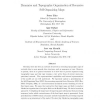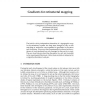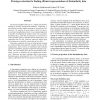367 search results - page 3 / 74 » Topographic Mapping of Large Dissimilarity Data Sets |
NECO
2006
13 years 7 months ago
2006
Recently, there has been an outburst of interest in extending topographic maps of vectorial data to more general data structures, such as sequences or trees. However, at present, ...
NIPS
1997
13 years 8 months ago
1997
The initial activity-independent formation of a topographic map in the retinotectal system has long been thought to rely on the matching of molecular cues expressed in gradients i...
ICPR
2002
IEEE
14 years 8 months ago
2002
IEEE
The nearest neighbor (NN) rule is a simple and intuitive method for solving classification problems. Originally, it uses distances to the complete training set. It performs well, ...
CIKM
2009
Springer
13 years 5 months ago
2009
Springer
In this paper, we present a framework for mining diverging patterns, a new type of contrast patterns whose frequency changes significantly differently in two data sets, e.g., it c...
ANNPR
2008
Springer
13 years 9 months ago
2008
Springer
Clustering constitutes an ubiquitous problem when dealing with huge data sets for data compression, visualization, or preprocessing. Prototype-based neural methods such as neural g...



